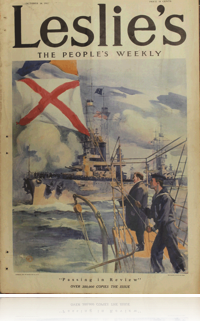
LESLIE’S WEEKLY
Frank Leslie’s Illustrated Newspaper, later renamed Leslie’s Weekly, was an American illustrated literary and news magazine founded in 1852 and published until 1922. It was one of several magazines started by publisher and illustrator Frank Leslie.
Throughout its decades of existence, the weekly provided illustrations and reports – first with wood engravings and Daguerreotypes, later with more advanced forms of photography – of wars from John Brown’s raid at Harpers Ferry and the Civil War until the Spanish-American War and the World War I.
The Illustrated Newspaper was founded in 1852. John Y. Foster was the first editor of the weekly, which came out on Tuesdays. There were 30 copies of the first edition printed. By 1897, its circulation had grown to an estimated 65,000 copies.
After Leslie’s death in 1880, the magazine was continued by his widow, the women’s suffrage campaigner Miriam Florence Leslie. The name, by then a well-established trademark, remained also after 1902, when it no longer had a connection with the Leslie family. It continued until 1922.
It often took a strongly patriotic stance and frequently featured cover pictures of soldiers and heroic battle stories. It also gave extensive coverage to less martial events such as the Klondike gold rush of 1897, covered by San Francisco journalist John Bonner.
Among the writers publishing their stories in the weekly were Louisa May Alcott. H. Irving Hancock, Helen R. Martin, and Ellis Parker Butler. Several notable illustrators worked for the publication, including Albert Berghaus and Norman Rockwell, who created covers for the magazine in its latter years, and Fernando Miranda y Casellas.
Surviving copies of the magazine at present fetch handsome prices as collectors’ items and are considered to give a vivid picture of American life during the decades of its publication.



